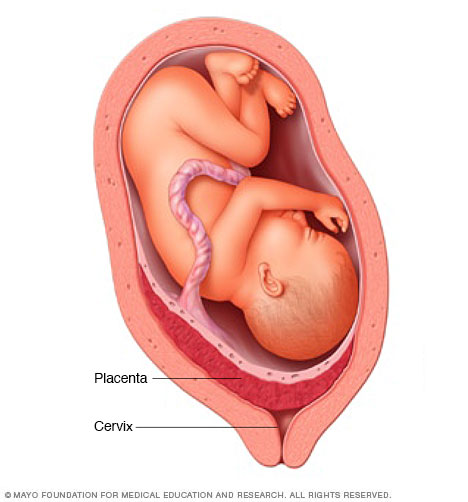Overview
Placenta previa

Placenta previa
The placenta is an organ that develops in the uterus during pregnancy. In most pregnancies, the placenta attaches at the top or on the side of the uterus. In placenta previa, the placenta attaches low in the uterus. The placenta might partially or completely cover the opening of the uterus, called the cervix. Placenta previa can cause severe bleeding in the mother before, during or after delivery.
Placenta previa (pluh-SEN-tuh PREH-vee-uh) is a problem during pregnancy when the placenta completely or partially covers the opening of the uterus (cervix).
The placenta is an organ that develops inside the uterus during pregnancy. It works to provide oxygen and nutrition to the baby and to remove waste. The placenta connects to your baby through the umbilical cord. Typically, the placenta is attached to the top or side of the inner wall of the uterus.
With placenta previa, the placenta attaches lower in the uterus. This results in some portion of the placental tissue covering the cervix. It can result in bleeding during the pregnancy or during or after delivery.
Changes in the uterus and placenta during pregnancy may lead to the problem correcting on its own. If it doesn't, the baby is delivered by cesarean section (C-section).
Symptoms
The main sign of placenta previa is bright red vaginal bleeding, usually without pain, after 20 weeks of pregnancy. Sometimes, spotting happens before an event with more blood loss.
The bleeding may occur with prelabor contractions of the uterus that cause pain. The bleeding may also be triggered by sex or during a medical exam. For some women, bleeding may not occur until labor. Often there is no clear event that leads to bleeding.
When to see a doctor
If you have vaginal bleeding during your second or third trimester, call your health care provider right away. If the bleeding is severe, seek emergency medical care.
Causes
The exact cause of placenta previa is unknown.
Risk factors
Placenta previa is more common among women who:
- Have had a baby
- Have had a previous C-section delivery
- Have scars on the uterus from a previous surgery or procedure
- Had placenta previa with a previous pregnancy
- Are pregnant after having an assisted reproductive technology (ART) procedure for treating infertility
- Are carrying more than one fetus
- Are age 35 or older
- Smoke
- Use cocaine
Complications
If you have placenta previa, your health care provider will monitor you and your baby to reduce the risk of these serious complications:
- Bleeding. Severe, possibly life-threatening vaginal bleeding (hemorrhage) can occur during the pregnancy, labor, delivery or in the first few hours after delivery.
- Preterm birth. Severe bleeding may prompt an emergency C-section before your baby is full term.
- Placenta accreta spectrum. Placenta previa is associated with a group of conditions called placenta accreta spectrum. With these conditions, the placenta grows into or through the wall of the uterus. Placenta accreta has a high risk of bleeding during pregnancy or during and after delivery.